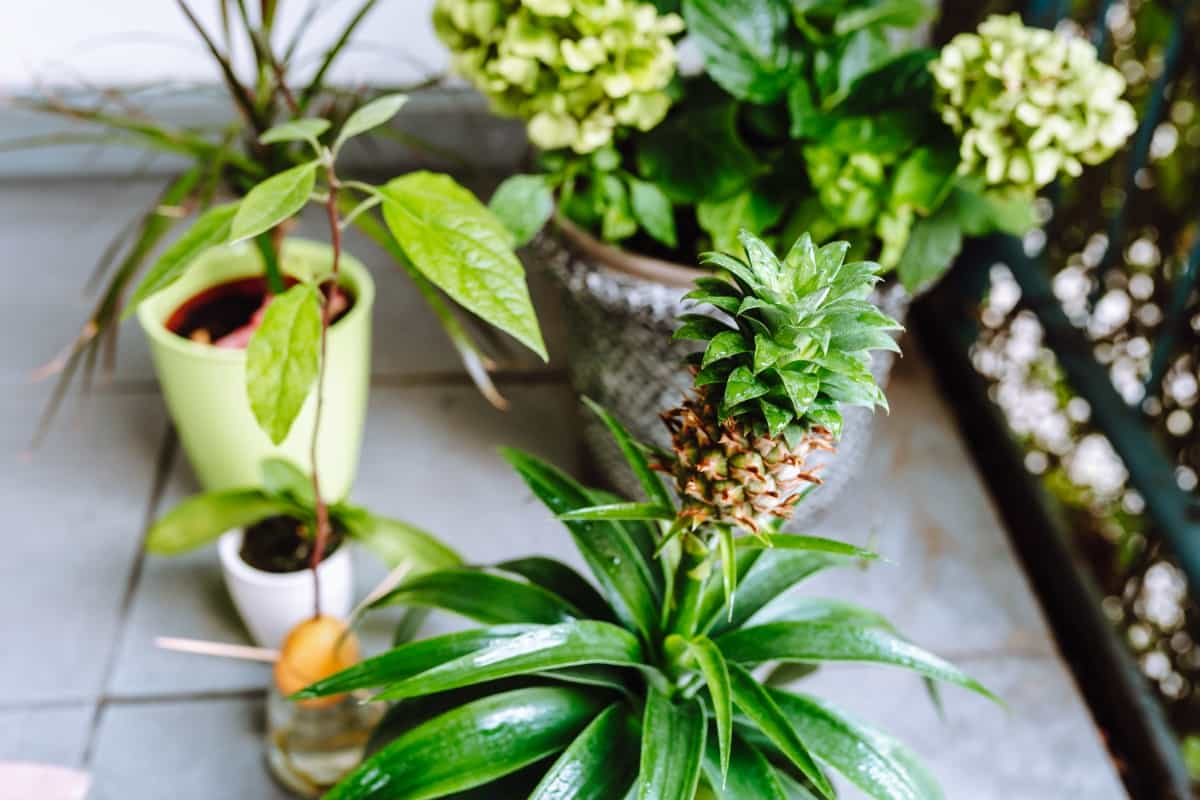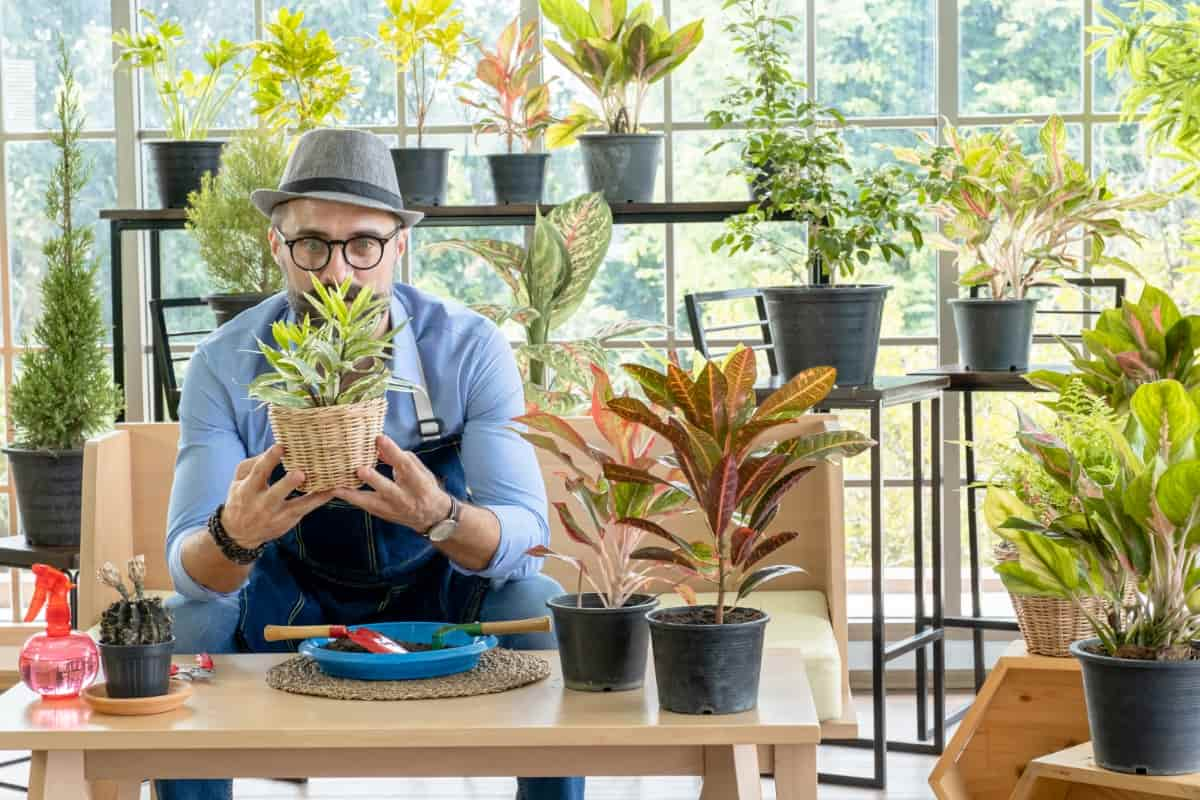A bushy plant not only looks visually stunning but also indicates optimal health and growth. Maintaining bushy houseplants is important for more than just aesthetics; it contributes to their overall health and well-being. Bushier plants have more leaves, which means increased photosynthesis and better air purification in your home.

Understanding Plant Growth Patterns
Houseplants have unique growth patterns that can vary depending on the species. Understanding these patterns is key to successfully encouraging bushiness in your indoor plants. Some plants grow vertically, reaching for the sunlight with tall stems and sparse foliage. Others tend to spread outwards, creating a bushy appearance with dense leaves and branches.
By observing how your plant naturally grows, you can tailor your care routine to promote bushiness. For example, if you have a trailing plant that tends to vine, providing it with a trellis or support structure can encourage it to grow fuller and more compact.
Choosing the Right Plant Species
Not all plants have the same growth patterns or requirements for achieving that full, lush look. Consider factors like light levels in your home and how much space you have available for a larger plant. Some houseplants thrive in bright, indirect light, while others prefer low-light conditions.
Some of the best houseplant species known for their ability to grow bushy include the Spider Plant, Pothos, Snake Plant, Peace Lily, and Fiddle-Leaf Fig. These varieties are relatively low-maintenance and have a knack for producing lush foliage when given proper care. If you’re aiming for a fuller appearance, look for plants known for their branching tendencies.
Optimal Lighting Conditions for Growth
When it comes to helping your houseplants thrive and become bushier, providing them with optimal lighting conditions is crucial. Different plant varieties have varying needs when it comes to light exposure, so understanding the requirements of your specific plants is key. Plants that require high light levels will need direct sunlight for several hours a day, while those classified as low-light plants can thrive in areas with minimal natural light. Medium-light plants fall somewhere in between, needing bright but indirect sunlight.
In case you missed it: Easy Homemade Recipes for Garden Plants: Natural and Organic Fertilizer for Vegetables, Flowers, and Houseplants

If you notice signs of stress like yellowing leaves or leggy growth, consider adjusting their placement to ensure they are receiving the right amount of light. Remember that rotating your plants periodically can help promote even growth on all sides and prevent them from leaning toward the light source too much. By paying attention to lighting conditions and making adjustments as needed, you can set your houseplants up for success in becoming lush and bushy additions to your indoor space.
Watering Techniques for Healthier Plants
It’s essential to understand that different plants have varying water requirements, so it’s vital to research the specific needs of each species you own. Overwatering houseplants can lead to root rot, while underwatering can cause wilting and stunted growth. To get the right balance, check the soil moisture level; if it feels dry, it’s time to water. When watering, ensure that excess water can drain out of the pot to prevent waterlogging. Water at room temperature is ideal as cold water can shock plant roots.
The Importance of Humidity for Indoor Plants
Indoor plants thrive in environments with adequate humidity levels. The moisture in the air plays a crucial role in their overall health and growth. Insufficient humidity can lead to dry, crispy leaves and stunted growth. To make an ideal growing environment for your houseplants, consider using a humidifier or placing trays filled with water near them. Misting the foliage occasionally can also help boost humidity levels around the plant.
There are many ways to increase humidity for your leafy friends. Grouping plants can create a microclimate where they naturally release moisture through transpiration and benefit from each other’s presence. Placing a water tray and pebbles near your plants helps elevate humidity as the water evaporates.
Another effective method is misting your plant’s leaves regularly with room-temperature water using a spray bottle. This mimics their natural habitat conditions and prevents dust buildup on their foliage. Apply in a humidifier is also an excellent option if you have multiple plants or struggle to maintain optimal humidity levels.
Fertilizing: What, When, and How Much
Fertilizing your houseplants is a crucial aspect of promoting bushiness and overall plant health. When it comes to choosing the right fertilizer for your plants, consider opting for a balanced liquid fertilizer or slow-release pellets specifically formulated for houseplants. As for the timing, generally fertilize during the growing season from spring through early fall when plants are actively growing.
In case you missed it: 20 Best Homemade Fertilizers for Money Plant: DIY Recipes and Application Methods

Stop fertilizing during the winter months when growth slows down. The amount of fertilizer needed varies depending on factors like plant species, size, and age. As a general rule of thumb, dilute the fertilizer to half or quarter strength to avoid burning roots and apply every 4-6 weeks during the growing season.
Pruning Techniques to Encourage Bushiness
Pruning is a crucial technique for encouraging bushiness in your houseplants. By removing dead or overgrown branches, you allow new growth to flourish and the plant to maintain its shape. When pruning houseplants, make sure to use clean and sharp tools to avoid unnecessary stress or damage. Focus on cutting just above a leaf node or bud at a slight angle to promote healthy regrowth. Don’t be afraid to prune regularly, but be mindful not to overdo it—moderation is key here.
While pruning, keep an eye out for any signs of disease or pests, as early detection can save your plant from potential harm. Remember that each plant species may require different pruning techniques, so always research the specific needs of your indoor greenery before getting started. With patience and practice, keep your houseplants lush and bushy through proper pruning methods.
Pinching Tips: Promoting Side Growth
Pinching is a simple yet effective technique for promoting side growth in houseplants. By strategically pinching off the tips of stems, you encourage the plant to grow bushier and fuller rather than tall and leggy. When using this method, it’s important to pinch above a leaf node to stimulate new plant growth.
This action sends a signal to the plant that it needs to branch out from that point, resulting in more lateral growth instead of vertical length. Regularly pinching back your plants can also prevent them from becoming top-heavy or lopsided. It helps distribute energy evenly throughout the plant, leading to a more attractive appearance overall.
Repotting: Encouraging a Healthy Root System
When you begin to notice roots circling the pot bottom or growing out of drainage holes, it’s time for a new home. Repotting not only provides more space for roots to grow but also refreshes the soil, ensuring optimal nutrient absorption. Select a larger pot with good drainage and use a quality potting mix suitable for your plant variety.
In case you missed it: How to Protect Indoor Plants in Winter: A Comprehensive Guide

Gently loosen the roots when transferring to avoid damage and promote new growth. Make sure not to rush this procedure; patience is key to helping your plants thrive. After repotting, water thoroughly and place your plant in an appropriate location based on its light requirements.
Using Growth Hormones Safely
These supplements can boost plant growth and help them become bushier, but they should be used with caution. Always follow the manufacturer’s instructions to ensure you are applying the correct dosage. Before applying any growth hormone to your plants, make sure to research how it will impact the specific species you are growing.
Not all plants react the same way to these products, so understanding your plant’s needs is crucial for successful results. It’s essential not to overuse growth hormones as this can harm your plants rather than benefit them. Stick to a regular schedule of applications based on the recommendations provided and monitor how your plants respond over time.
The Role of Air Circulation in Plant Health
Air circulation plays a crucial role in maintaining the health of your houseplants. Adequate airflow helps prevent issues like mold, mildew, and pest infestations by reducing excess moisture around the plants. It also strengthens plant stems and encourages proper transpiration, leading to healthier growth overall. Placing your houseplants near a window or using a fan to move the air gently can improve circulation indoors.
Avoid overcrowding house plants in one area, as this can create stagnant pockets where air doesn’t flow effectively. Additionally, periodically opening windows or doors allows fresh air to circulate through your home and benefits your green companions. Good air circulation is especially important for tropical plants that thrive in humid environments since it helps mimic their natural habitat conditions.
Identifying and Managing Pests and Diseases
Pests and diseases can be a real buzzkill when it comes to keeping your houseplants bushy and vibrant. Identifying these pesky invaders early on is crucial for effective management. Look for common signs like yellowing leaves, unusual spots, or sticky residue, which could indicate the presence of pests. Research online resources or consult with local plant experts to accurately identify the issue at hand.
In case you missed it: Bolting Management in Plants: Prevention for Premature Flowers and Seeding in Crops and Vegetables

Once you’ve pinpointed the problem, consider natural remedies such as neem oil spray or introducing beneficial insects to combat pest infestations without harming your plants. For diseases, proper sanitation practices like removing affected leaves and maintaining good airflow around plants can help prevent their spread. Remember that prevention is key – inspecting your houseplants and providing optimal growing conditions will go a long way in keeping them healthy and pest-free.
Utilizing Support Structures for Plant Shaping
Support structures can help guide your plants’ growth in the desired directions, creating a fuller and more visually appealing appearance. Support structures come in various forms, such as stakes, trellises, or frames. By strategically placing these near your plants, you can encourage them to grow upwards or outwards instead of becoming leggy or droopy. Climbing plants like pothos or philodendrons particularly benefit from support structures as they naturally thrive when given something to climb on.
This not only enhances their aesthetics but also helps maintain their overall health by preventing overcrowding and promoting better air circulation around the foliage. Experimenting with different types of support structures can add an element of creativity to your indoor garden while keeping your plants looking vibrant and well-maintained.
Seasonal Care Variations
Understanding how to adjust your care routine according to seasonal variations is crucial for maintaining their health and promoting bushiness. Houseplants tend to grow rapidly during the warmer months. Therefore, increase watering frequency and monitor soil moisture levels regularly. In contrast, winter brings shorter days and lower light levels. To support growth during this time, consider moving your plants closer to windows or supplementing with artificial lighting.
Temperature fluctuations can also impact plant growth. Keep an eye on indoor temperatures and use a humidifier if the air becomes too dry. Seasonal changes may also require adjustments in fertilizing schedules. Tailor your feeding regimen based on the specific needs of each plant species throughout the year.
Creating a Fertilizer Schedule
Creating a fertilizer schedule is crucial for maintaining the health and bushiness of your houseplants. Different plants have varying nutrient requirements, so it’s essential to tailor your fertilizing routine accordingly. Start by researching each plant’s specific needs in your collection. Some may require more frequent feeding during their active growth periods, while others might prefer a lighter feeding schedule throughout the year.
In case you missed it: Beetle Management in Plants: Control and Prevention Strategies

Consider using organic fertilizers to promote overall plant health and avoid chemical buildup in the soil over time. Keep track of when you last fertilized each plant to prevent overfeeding or underfeeding. Maintaining consistency in your fertilizer schedule will help encourage lush growth and vibrant foliage in your indoor garden.
Monitoring and Adjusting Care Based on Plant Responses
Monitoring your plants’ reactions can help you adjust your care routine accordingly for optimal growth and bushiness. Keep an eye on the leaves – yellowing or browning could indicate overwatering or nutrient deficiencies. Wilting may be a sign of underwatering. Observe how your plant responds to its current lighting conditions. If it starts leaning towards the light source, it might need more sunlight. Check for any signs of pests or diseases regularly.
Early detection can prevent these issues from spreading and affecting your plant’s overall health. Consider factors like temperature and humidity levels in your home that may impact plant health. Adjust as needed based on how your plants are reacting. Houseplants bring life and vibrancy into our indoor spaces, creating a calming and inviting atmosphere. By following these effective tips and ideas on how to make houseplants bushy, you can ensure that your indoor greenery thrives and flourishes.
- Types of Pesticides Used in Agriculture: A Beginner’s Guide
- Economical Aquaculture: A Guide to Low-Budget Fish Farming
- 15 Common Planting Errors That Can Doom Your Fruit Trees
- How to Make Houseplants Bushy: Effective Tips and Ideas
- Innovative Strategies for Boosting Coconut Pollination and Yield
- Pollination Strategies for Maximum Pumpkin Yield
- The Complete Guide to Chicken Fattening: Strategies for Maximum Growth
- Natural Solutions for Tulip Problems: 100% Effective Remedies for Leaf and Bulb-Related Issues
- Revolutionizing Citrus Preservation: Towards a Healthier, Greener Future
- Natural Solutions for Peony Leaf and Flower Problems: 100% Effective Remedies
- Maximizing Profits with Avocado Contract Farming in India: A Comprehensive Guide
- Natural Solutions for Hydrangea Problems: 100% Effective Remedies for Leaf and Flowers
- The Ultimate Guide to Choosing the Perfect Foliage Friend: Bringing Life Indoors
- From Sunlight to Sustainability: 15 Ways to Use Solar Technology in Agriculture
- The Ultimate Guide to Dong Tao Chicken: Exploring from History to Raising
- The Eco-Friendly Makeover: How to Convert Your Unused Swimming Pool into a Fish Pond
- Mastering the Art of Delaware Chicken Farming: Essentials for Healthy Backyard Flocks
- 20 Best Homemade Fertilizers for Money Plant: DIY Recipes and Application Methods
- How to Craft a Comprehensive Free-Range Chicken Farming Business Plan
- Brighten Your Flock: Raising Easter Egger Chickens for Beauty and Bounty
- How to Optimize Your Poultry Egg Farm Business Plan with These Strategies
- Subsidy for Spirulina Cultivation: How Indian Government Schemes Encouraging Spirulina Farmers
- Ultimate Guide to Raising Dominique Chickens: Breeding, Feeding, Egg-Production, and Care
- Mastering the Art of Raising Jersey Giant Chickens: Care, Feeding, and More
- Ultimate Guide to Raising Legbar Chickens: Breeding, Farming Practices, Diet, Egg-Production
- How to Raise Welsummer Chickens: A Comprehensive Guide for Beginners
- How to Protect Indoor Plants in Winter: A Comprehensive Guide
- Ultimate Guide to Grow Bag Gardening: Tips, Tricks, and Planting Ideas for Urban Gardeners
- Guide to Lotus Cultivation: How to Propagate, Plant, Grow, Care, Cost, and Profit
- Agriculture Drone Subsidy Scheme: Government Kisan Subsidy, License, and How to Apply Online
- Ultimate Guide to Raising Araucana Chickens: Breed Profile, Farming Economics, Diet, and Care
- Bringing Hydroponics to Classroom: Importance, Benefits of Learning for School Students
- Ultimate Guide to Raising Polish Chickens: Breed Profile, Farming Economics, Diet, and Care
- Ultimate Guide to Raising Australorp Chickens: Profile, Farming Economics, Egg Production, Diet, and Care
- Silkie Chicken Farming: Raising Practices, Varieties, Egg Production, Diet, and Care
- Sussex Chicken Farming: Raising Practices, Varieties, Egg Production, Diet and Care